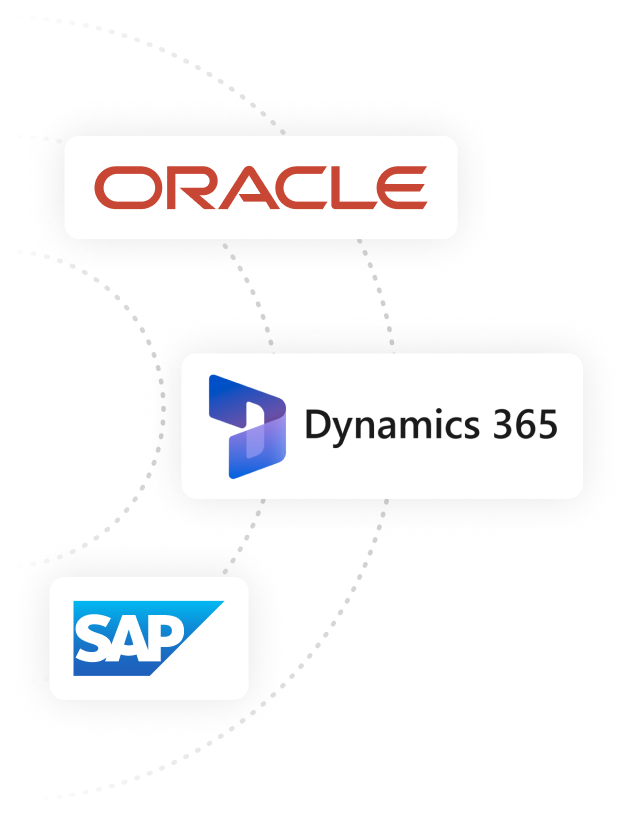

Adapt to change with our change management consulting solutions
By applying a people-focused approach, our change management consultants help you navigate complex transformations, promote adoption, and achieve change success.
Organizational Change Management
People-focused change management consulting services
With our people-focused approach and change management framework, we ensure a smooth transition for your teams, allowing you to maintain a competitive edge. Whether you're managing a complex merger, implementing an ERP system, or updating outdated business processes, our change experts can help.
OCM for SAP
OCM for Oracle
OCM for Microsoft Dynamics 365
Strategic Transformation
Communication & Training
Executive Leadership Alignment & Coaching

Is your firm ready for transformation?
Empower your organization's transformation journey with our comprehensive change management assessment.
Take proactive steps today to navigate your organization’s large-scale transformation seamlessly, equipped with the insights and strategies necessary to overcome challenges and achieve lasting results.


Accelerate ERP adoption
Maximize your ERP investment and prepare your organization to adopt new technology and processes.
Our team of experts specializes in all major ERP applications, including Oracle Fusion Cloud, Microsoft Dynamics 365, SAP, and more. We understand the challenges associated with ERP implementations, migrations, and upgrades: resistance to change, training gaps, communication breakdowns, change fatigue, and more.
As a part of our tailored change management strategies, our expert consultants will work with you to develop comprehensive communication plans, targeted training programs, leadership alignment initiatives, and ongoing support mechanisms. By addressing these challenges head-on, we’ll ensure a smooth transition to your new ERP system.
Overcome inefficiency and boost productivity
Realize your organization's full potential with our expert process change management services. From streamlining workflows to optimizing processes, we will guide you through every stage of your transformation. By partnering with us, you'll eliminate inefficiencies, increase productivity, improve quality, and increase agility in your operations.


Drive seamless digital transformation
Mitigate disruption with our tailored technology change management solutions. Whether you're looking to implement a new ERP system, upgrade infrastructure, or embrace digital transformation, our seasoned experts are here to help. Let us help you drive growth, innovate, and gain a competitive edge.
Strengthen workplace culture
Foster a culture of resilience, collaboration, and productivity amidst the changing dynamics of remote, hybrid, and return-to-office work arrangements.
As the workforce landscape evolves, so do the challenges of managing change, especially when transitioning between different work models.
Whether you need help with remote, hybrid, or return-to-office change management, our change consultants have the tools, strategies, and expertise to ensure smooth transitions and boost team engagement — wherever your team may be.


Empower your team and overcome resistance
Build trust and navigate change seamlessly through empathy, communication, and empowerment.
Our change consultants specialize in guiding teams through transitions, addressing resistance to change, low employee morale, communication breakdowns, skill gaps, leadership alignment challenges, and more.
Activate the full potential of your most valuable asset — your people — with our people-centric change management solutions that foster resilience and cultivate a culture of continuous learning and growth.
CASE STUDY
Driving D365 ERP Success with Organizational Change Management at CountryMark


The Problem
CountryMark, an oil and gas leader, faced challenges transitioning from AX2012 to D365 Finance and Supply Chain Management, requiring internal leadership to own the upgrade process while adapting to Microsoft's bi-annual upgrade cadence. The company needed a structured approach to manage both technical and organizational changes.
The Solution
AXIA Consulting embedded Organizational Change Management (OCM) into the upgrade strategy, focusing on leadership engagement, team collaboration, and a clear communication plan. Key initiatives included:
- Leadership Buy-In: Ensured executive involvement and accountability.
- Train the Trainer Program: Built internal expertise for long-term knowledge retention.
- Change Agent Program: Ongoing coaching and communication to drive user adoption.
The Results
- Leadership Ownership: Leaders fully engaged in managing the ERP process.
- Enhanced Team Cooperation: OCM reduced frustration and fostered collaboration.
- Sustainable Knowledge: The team is now equipped to handle future upgrades confidently.
CASE STUDY
Case study option 2
Cras mattis consectetur purus sit amet fermentum. Cras justo odio, dapibus ac facilisis in, egestas eget quam. Sed posuere consectetur est at lobortis.
60%
80%
6
90%
Our OCM experts


Bianka Shah
Managing Director, Business Consulting and Organizational Change Management

Fanya O’Donoghue
Practice Director, Organizational Change Management

Sarah Finefrock
Director, Organizational Change ManagementIndustry-specific consulting expertise
Financial Services
Empower innovation and collaborative thinking within your organization during transformation programs driven by regulatory requirements, technology advancements, or shifting market demands.
Technology
Govern stakeholder expectations, manage resistance to change, and address messaging and training for digital transformation and agile ways of working to empower teams and enhance technology investments.
Construction & Engineering
Foster adoption and sustainment of changes in business processes and technology while driving improvements in productivity, safety, and project outcomes.
AXIA Insights
AXIA Insights









